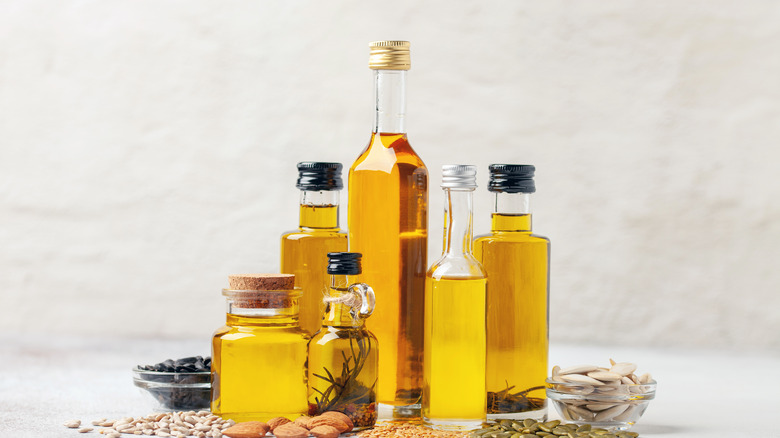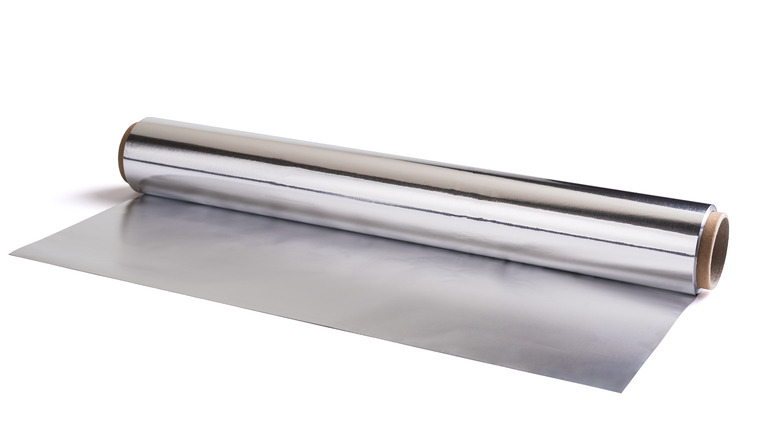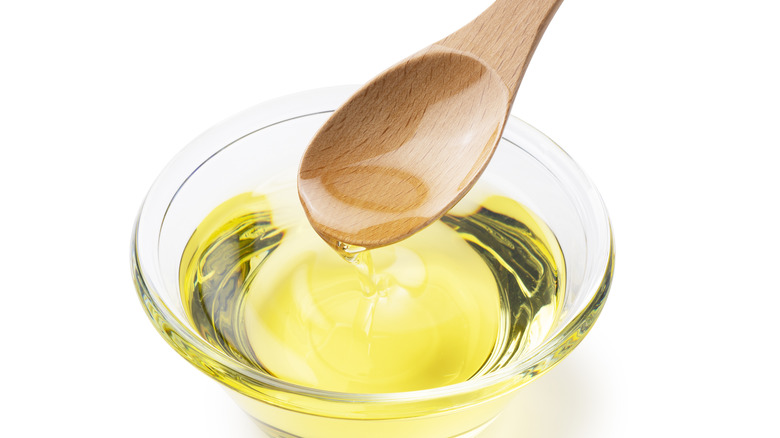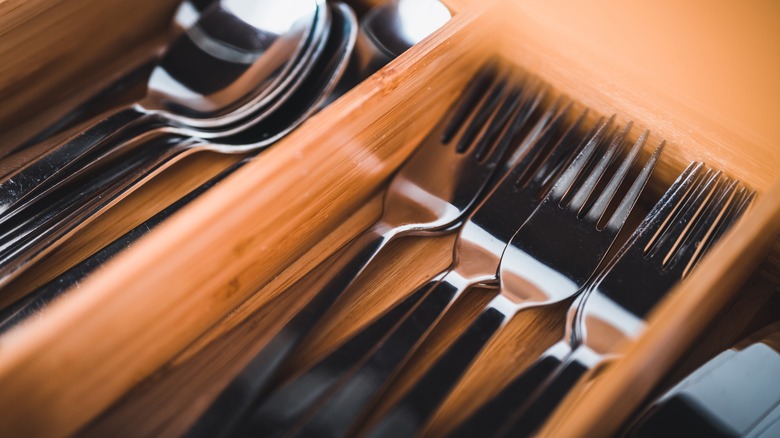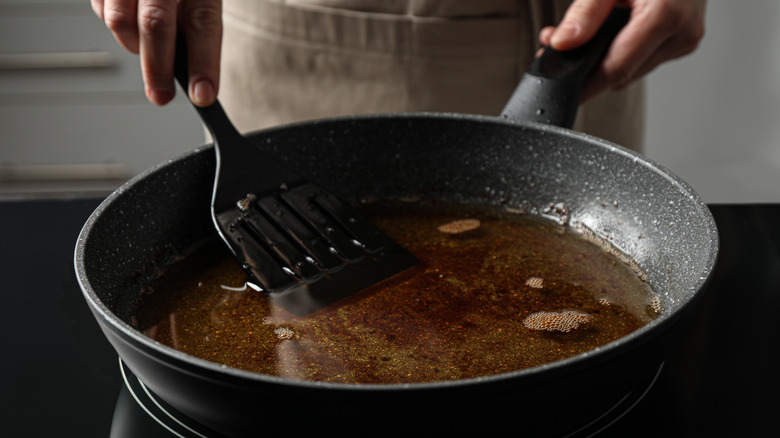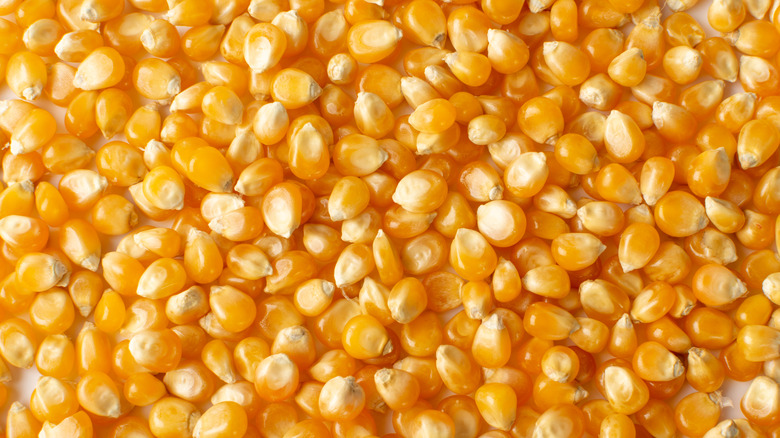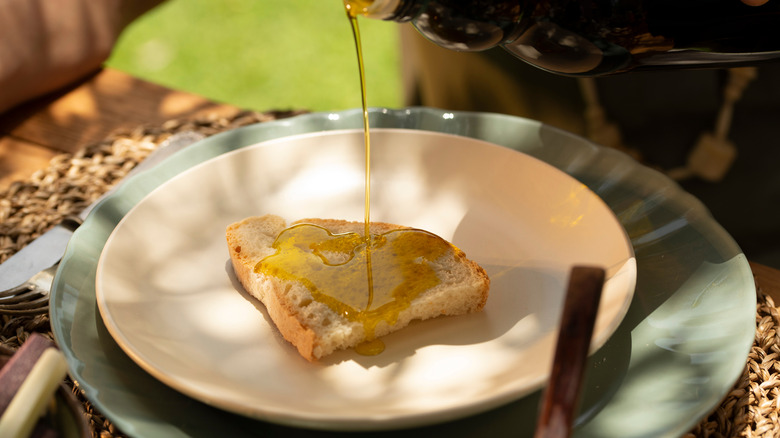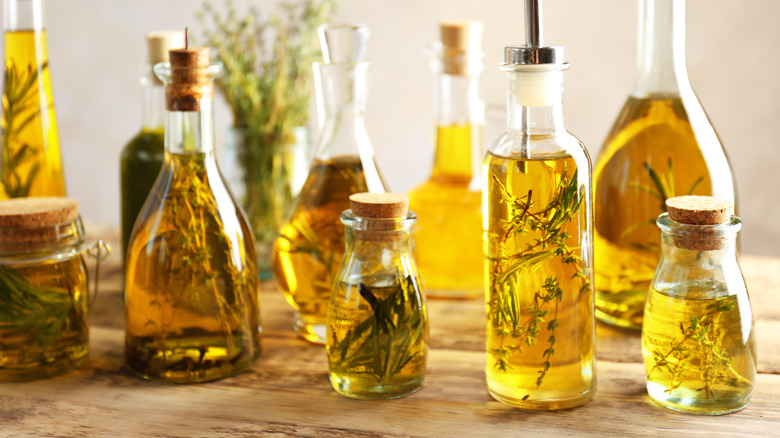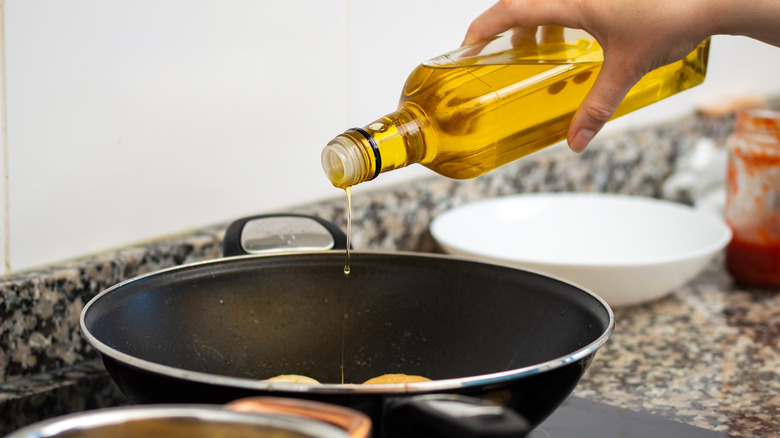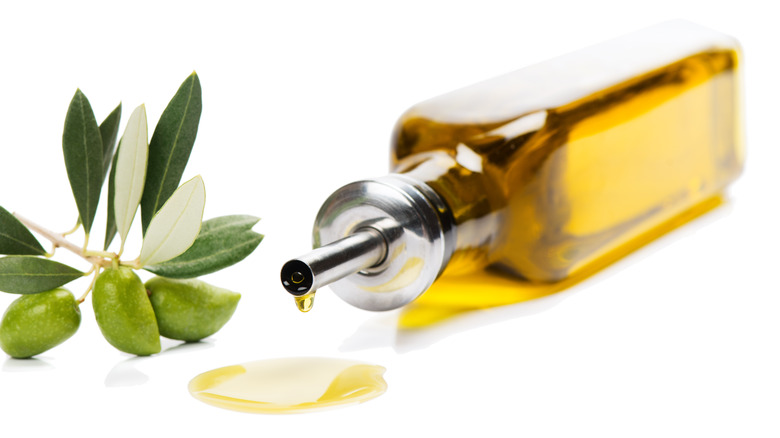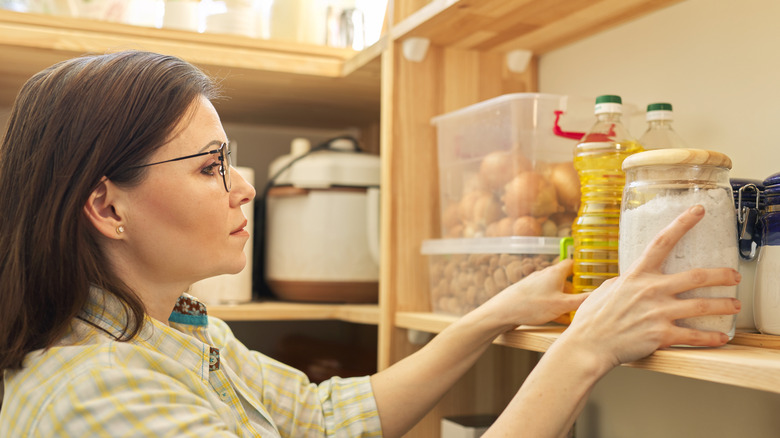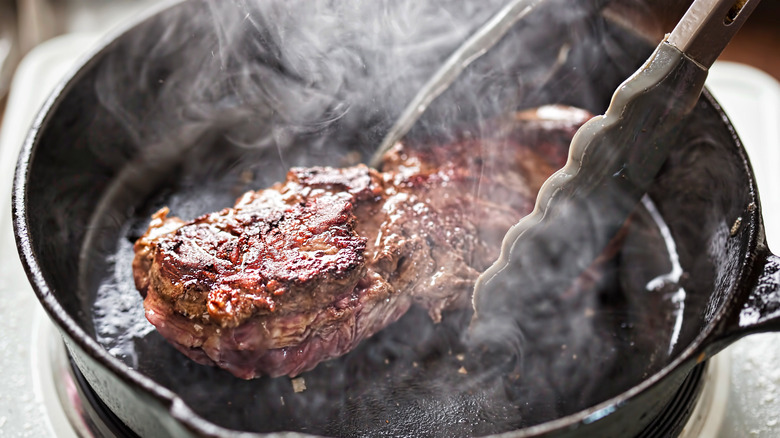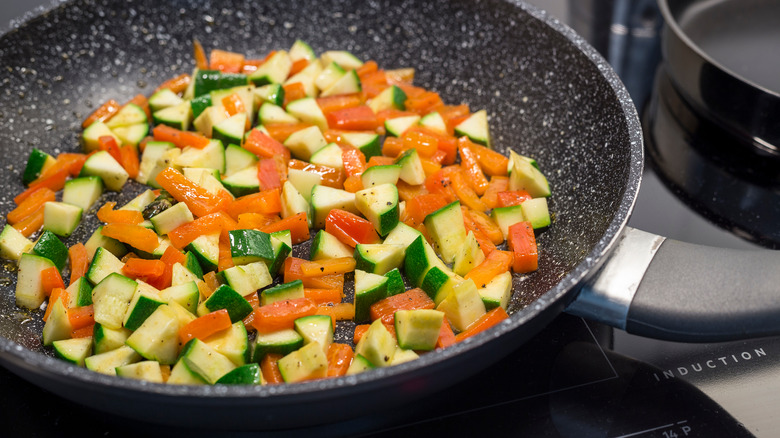Tricks You Need To Know When Cooking With Oils
It's no secret that cooking food in oil produces tasty results, whether you make fried fish sticks or crispy French fries. Aside from frying, people utilize this type of fat with other cooking methods like roasting and sautéing as well. Oil is also a pantry essential with different purposes where heat isn't involved; salad dressings are just one example. There are various cooking oils out there, and each has its uses; that's why it's vital to know how to choose the right oil for the job. Some types, like sesame oil, are best used as a finishing oil, while vegetable oil is fantastic for stir-frying and baking.
When you use oil in the right way, it improves food's texture and flavor. Whatever type of food you create, you must know some kitchen hacks when working with cooking oil, or it gets messy quickly. These techniques are incredibly beneficial whether you are simply measuring out ingredients, cleaning up an oil spill, or dealing with piping hot oil. You might just be surprised how much easier cooking is when you incorporate these hacks into your daily life.
Use aluminum foil to dispose of hot oil safely
One of the hairiest parts of cooking with oils is when it's time to drain it. It takes caution to guarantee no oil goes down the drain or comes in contact with your skin. Thankfully, the aluminum foil hack for disposing of hot cooking oils makes the whole process a breeze. A TikTok user, @icevee, posted a genius video where they placed a layer of foil in their sink before draining the oil and grease from ground meat. This practice is wise, since aluminum foil handles high temperatures with no problem.
To try this trick out, cut off a piece of aluminum foil that is at least as large as the circumference of your colander. Next, place the foil in the sink and press it down where the drain is, which helps hot liquid to flow downward toward the center rather than oozing into the rest of the sink. Place the strainer over the foil and use it to separate the food and the hot oil. Finally, fold up the aluminum foil with the liquid fat inside and throw it away. This hack works with any oil, whether it be hot vegetable oil or simply bacon grease. Just make sure that the oil doesn't overflow into the sink, which defeats the whole purpose; work in stages if you have a large amount.
Grease your cooking tools to prevent food from sticking to them
Work smarter, not harder, by dipping various cooking utensils in oil before use; this is the clever way José Andrés keeps eggs from sticking to spatulas. There is no denying that eggs, whether they're fried, scrambled, or prepared in another way, have a tendency to stick to tools and pans. To combat this, dunk the spatula in some oil before introducing eggs to the pan. The cooking fat works as a protective layer for the spatula; thus, it preserves its cleanliness and keeps the eggs where they should be.
Another way to use this trick is when you're measuring sticky baking ingredients. When you need to put components like honey or molasses in a measuring cup, first line the cup with a light coat of oil. Then, the typically tacky ingredient will easily pour out when needed. Additionally, the cooking fat helps cheese not to cling onto graters when you shred it. To use this method, grab a bit of olive oil and apply it to the tool; this assists the cheese in sliding right off. Once you try this neat approach, you'll never return to grating cheese on a dry grater again. Ultimately, oiling certain utensils saves you time and removes minor annoyances, which all adds up and make the whole cooking process more enjoyable.
Use the fork hack for the perfect vegetable oil pour
Finding a new way to be more productive in the kitchen is always fun, especially when you find techniques like this vegetable oil hack that will change your cooking game. The best part is that a fork is all you need for this helpful trick. In the future, when you open a fresh bottle of vegetable oil, do not rip the seal off. Instead, open the silverware drawer and get yourself a fork. Use the flatware to puncture small openings in the film, which gives you the perfect pour when you cook with the oil.
The miniature perforations make it much easier to manage how much cooking fat gushes out at once. If you use vegetable oil for baking projects or you generally use it in large amounts, this practice might not be ideal for your household. However, if you tend to use oil more sparingly, this hack may be right up your alley. Utilize the portion-controlled oil for things like making homemade vinaigrette, roasting veggies, or lightly coating meat before it goes in the oven.
Clean used oil so you can repurpose it
This trick is for the thrifty folks who aim to avoid food waste as much as possible in their home. There are methods to clean certain oils you've used, and better yet, there are ways to use that leftover frying oil. Provided that you didn't use the oil to fry seafood, it is safe to reuse it between three to six times. Use your best judgement; the oil should not have a foul smell. One straightforward way to eliminate impurities is to strain the used oil with a coffee filter. Of course, you'll want to have the filter lined in some type of sieve, because the thin paper can't hold all that weight on its own. Furthermore, there is a genius way to clean used frying oil that you never knew about, and it involves gelatin. If you've got some of the unflavored kind, consider yourself lucky.
Mix the gelatin with some warm water to dissolve it before you blend it into the cooled oil. What is the correct measurement to utilize? 1 teaspoon of gelatin and ½ cup of water per every 4 cups of oil. So, you've thoroughly mixed the gelatin mixture into the cooking fat; now what? Let the liquid reside in the refrigerator for roughly eight hours or overnight. When you check on it, the gelatin and any food particles will have bundled into something resembling a hockey puck (astonishing, right?). Scrap the solidified gelatin glob, and you've got some oil to cook with that's good as new.
Use a popcorn kernel to determine when frying oil is ready
If you don't own a thermometer, it is tricky to tell when frying oil is ready for use. Of course, you can throw a piece of food in to try and gauge the temperature, but sometimes that just leaves you with a saturated bit of food sitting in lukewarm liquid. On the other hand, you flirt with danger if you wait too long to test the temperature and it overheats. But what if you learned that a popcorn kernel could fix the cooking mistake of introducing your food to the oil either prematurely or belatedly?
Since popcorn kernels pop between 325 to 365 degrees Fahrenheit, they are the perfect vessel to estimate the oil's temperature. Drop a grain into the oil and wait for the ever-so-familiar popping sound, which is your green light to get cooking. If you want, out of an abundance of caution, you can use a few kernels rather than just one, to be sure. And don't forget to dispose of the popcorn before you begin the actual cooking process.
Try out the TikTok hack for drizzling olive oil
Your new favorite kitchen trick might be the olive oil TikTok hack that changes everything. Have you ever attempted to drizzle your food with olive oil lightly, and a huge stream poured out, drenching the food instead? We've all been there, but never again after watching a TikTok user's video that promptly solves this issue. The media caption reads, "like seriously, TikTok is awesome for teaching me something I didn't know," with many folks in the comments agreeing.
In the video that's impressively racked up over a million likes, @chaldomom shows how to use the pull tab to your advantage. If your new bottle of oil has a plastic cap (rather than a metal one), don't discard the seal flap after you open the container. After you remove it, turn the tab topsy-turvy, return it to the bottle opening, and nestle it into place. With this brilliant method, spills or overpours are much less likely. This is because there is a thin flow of oil that comes out rather than an overwhelming surge. Before getting carried away, though, test it out to make sure the flap is secure enough.
Infuse your oil for added flavor
One of the absolute best ways to get creative with cooking oil is to infuse it for a deeper flavor profile. Pre-infused oils are available to buy, but it's entirely possible to make herb-infused oil at home. You just can't beat the taste of fresh herbs, which is why it is best to use them instead of dried herbs. Place the herbs of choice in a glass jar along with any seasonings you enjoy (black pepper, for example) and fresh citrus zest. Bring the oil to a warm temperature as preparation (it doesn't have to be strictly olive oil, it can be a blend). Then transfer the oil to the herb-filled container and allow it to sit, covered with linen, for at least half a day. Lastly, strain it to complete the task.
Alternatively, there is another oil trick to use before you throw away any fruit peels. Use lemon or orange peels, whichever you prefer. Fill a glass container with room-temperature olive oil and add the citrus rinds to it. Allow the flavors to marry for at least seven days before working with it. Both of these methods to create infused oil are unbelievably simple, and you reap all the benefits when your food becomes next-level delicious. Enhance foods like salads, vegetables, meat, and bread with flavored oils; there are endless ways to use them creatively.
Mix old olive oil with other oils to raise its smoke point
If you find that an oil is approaching its expiration date, make use of it instead of tossing it in the trash. What is there to do with old olive oil, you might ask? There are a number of approaches, but mixing it with other oils to create a blend is one of the best (this is because it raises the fat's smoke point). You should use olive oil lightly; for example, drizzle it atop potatoes before roasting them or use it in a meat marinade.
Olive oil surely isn't the optimal choice for frying. For this reason, it can be challenging to use large amounts of it at once. However, when you incorporate it into an oil blend, it gives you more freedom to use it in different ways. Of course, once you do so, you'll want to use it sooner rather than later. It looks like it's time to try out that fried chicken recipe you've been eyeing.
Sprinkle flour on cooking oil spills for an easy cleanup
Those who have spilled oil while cooking can attest that it is a pesky mess to clean. Regardless of how many paper towels you use, there is never-ending grease to deal with. Here is some good news: There is an easy trick for quickly cleaning up spilled oil. Open the kitchen cupboard and grab a dry ingredient such as flour or cornmeal. Sprinkle the powdery ingredient atop the fat you've lost to the floor or counter, and it promptly soaks up the liquid. You might think you've just made a more difficult heap to clean, but you certainly didn't. Take a broom and sweep up the pile; it lifts from the surface effortlessly. There might be a small amount of residual grease, which some soap and warm water takes care of.
If you don't have flour, baking powder or soda is another option, but you might want to use those for more minor accidents. After all, you don't want to waste the whole container of baking powder.
Store cooking oils away from the stove for longer shelf life
How you store foods plays a significant role in how long their shelf life lasts, and cooking fats are no exception. For instance, you wouldn't store a gallon of milk in the pantry because the temperature there would negatively affect how long it stays fresh. The same goes for oil. It is undoubtedly tempting to store it within reach of where you cook so you don't need to go out of your way to grab it, but keeping your oil near high-heat areas like the stovetop (in fact, this is one of the ways you are misusing oil) can cause it to go bad prematurely. You should keep oil in low light and at room temperature; this practice helps prevent it from going sour too quickly.
In addition, stock cooking fats in a place free of moisture. These rules apply to all the major cooking oils (coconut, olive, vegetable, and soybean oil are just a few examples). Ensure you entirely seal cooking fat containers between uses. Finally, take additional measures for nut oils and store them in a chilled environment, perhaps the refrigerator.
Add room-temperature oil to smoking oil to cool it down
Gordon Ramsay undoubtedly knows his way around a kitchen, so it's no surprise he has a solution for when frying oil gets too hot. If cooking oil is near its smoke point or already smoking, it is easy to panic, especially if you've already submerged food in it. Nobody wants a smoky house or food that is undeniably burnt. With Ramsay's essential practice, you no longer need to endure those inconveniences. On his official YouTube channel, he constantly gives home cooks insight on overcoming inevitable setbacks just like this.
Specifically, in a video where he shows the viewer how to cook three different recipes, he advises that all you need to do is incorporate some unheated fat into the mix when your oil's temperature is too high. Remove the pot from the heat source simultaneously to go a step further. Combine these two efforts to save your oil and food from disaster instantly. A kitchen thermometer makes things much more straightforward because you'll be able to determine when it is safe to place the pot back on the heat.
Toss your food in oil first instead of oiling the pan itself
Do you always have trouble with hot oil splattering on you when you cook with it? The popping oil is not only a nuisance, but also dangerous since it can cause burns on your arms or other exposed skin. Fortunately, there is a secret trick that will stop splattering oil forever, so you don't have to tolerate it anymore. Instead of coating your pan in oil and adding food to the hot liquid, cover the food in a light layer of oil before adding it to the pan.
Another benefit is that you also reduce food waste because there isn't excessive oil in the pan. The most effective way to do this is to grab a bowl and mix the vegetables or meat in a small amount of oil until it is evenly covered. Another option is to brush the oil directly onto the food or use gloves and rub it on. Of course, you still need to place the food in the hot pan with care, but trust us when we say that it makes all the difference in reducing the amount of popping oil.
